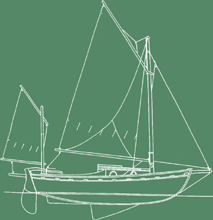Last week we went out to get ready for bottom painting (oh, hush!) but Detail Girl became sidetracked by the leading edges of the bilge keels. Too square, they were, and in dire need of rounding off ("mumble overseas mumble first place mumble fritz...").
Sooooo I went at them with a chisel, and Detail Girl (I really have to make her a T-shirt) sanded them, and we put on a coat of primer, and we sanded the rest of the primer, and we washed the hull, and that was pretty much our evening. Dad was good enough to sand and add another coat of primer (after all, this was bare wood, not sealed like the rest of the bottom) the next morning.
When we arrived last night, we sanded the second coat of primer and Pronounced It Good. Then it was time to build a water level and mark the waterline in preparation for the aforementioned bottom painting (stop giggling!). What's a water level, you ask? Well, I say, I'll tell you.
Long ago in Olden Tymes, there was no such thing as laser levels. Shocking, I know. So in order to make sure a bunch of things were at the same level, you either measured from a known reference, or you used a water level. They're particularly good for waterlines, given the irregular shape of a hull.
We built ours from an old piece of Tygon™ tubing, a piece of garden hose to which the tubing was carefully joined (ah, electrical tape), a pail, and a dive-belt weight to hold the end of the hose at the bottom of the pail. Here's a picture:
 You can see one end of the hose disappearing into the pail; the business end is the tubing, temporarily jammed into the pail handle for safekeeping.
You can see one end of the hose disappearing into the pail; the business end is the tubing, temporarily jammed into the pail handle for safekeeping.To set up the level, we placed the tubing end up against the transom/keel joint and added water to the pail until the meniscus (look it up if you have to!) was at the right level for the line between the bottom paint and the boot stripe. Then we moved the tubing along the hull, marking out the waterline from stern to bow on both sides.
After that came the fun of springing a batten along the marks to get the fairest line possible, and marking the line on the hull. This took six hands in places (Mom helped) because wood doesn't like to be bent like that. We think the line looks pretty good.
 The next step was to very carefully tape off the line with expensive blue masking tape, which has a very fine edge, then add another strip of cheaper and wider masking tape below the blue stuff. By the time we finished all that, and disassembled the water level and returned its parts to their proper places, it was time to head home. But we're all set to put on two coats of bottom paint over the weekend. See how good the tape line looks? (Oooooh. Aaaaah.)
The next step was to very carefully tape off the line with expensive blue masking tape, which has a very fine edge, then add another strip of cheaper and wider masking tape below the blue stuff. By the time we finished all that, and disassembled the water level and returned its parts to their proper places, it was time to head home. But we're all set to put on two coats of bottom paint over the weekend. See how good the tape line looks? (Oooooh. Aaaaah.)Oh yeah, you can also see the newly rounded bilge keels if you look closely at the second picture. Which I know you all will. Heh.





